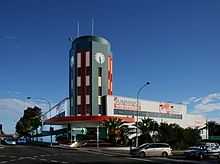Bunnings Warehouse
 | |
| Subsidiary | |
| Industry | Retail/Trade Hardware |
| Founded | Western Australia, in 1952 |
| Headquarters | Hawthorn East, Victoria |
Number of locations | 324 (2015)[1] |
Key people | John Gillam (CEO) |
| Revenue |
|
| Parent | Wesfarmers |
| Slogan | Lowest Prices Are Just The Beginning |
| Website | http://www.bunnings.com.au/ |
Bunnings Warehouse is Australia's largest household hardware chain[3] with stores in Australia and New Zealand.[4] The chain is owned by Wesfarmers Limited.
History

Pre 1900s
In 1886 brothers Arthur and Robert Bunning left London to settle in Perth, Western Australia, and soon gained a government building contract, which led to them founding a group of building companies which later became 'Bunning Bros Pty Ltd'. They purchased their first sawmill the following year in the south west of Western Australia,[5] and over the next few years they concentrated more on sawmilling and timber distribution and less on building.[6]
20th century
The company expanded to include several new mills around Western Australia. In 1952, Bunnings Limited became a public company, expanded into retailing and purchased several hardware stores.[6] In 1970, Bunnings bought the merchandising and sawmilling operations of the Hawker Siddeley Group. In 1983, they bought out Millars (WA) Pty Ltd and, in 1990, the Alco Handyman hardware operations. The Victorian and South Australian hardware stores McEwans, owned by James McEwans Ltd, were acquired by Bunnings in 1993, many being then closed, leaving only the best performers. Bunnings Limited was then bought out by Wesfarmers Limited in 1994.
Store development post-1994

After the acquisition of Bunnings by Wesfarmers, the first Bunnings Warehouse was opened in the Melbourne suburb of Sunshine by then Victorian premier Jeff Kennett and Joe Boros, the managing director of Bunnings. This was quickly followed by three other Melbourne stores. Subsequently, new warehouses have been opened, on average, every three months across Australia. Development in Sydney and Brisbane proved more difficult than in other areas, as large blocks of land in the metropolitan area were limited. In 1997, the remaining smaller-format McEwans stores were renamed "Bunnings".

In August 2001, Wesfarmers bought the Howard Smith Group, owner of BBC Hardware and their big-box offshoot, Hardwarehouse. This supplemented the Bunnings national network by several dozen stores, many of them large Hardwarehouse stores in Sydney, Brisbane and New Zealand. Hardwarehouse had been dominant in New South Wales and Queensland, but the purchase complemented Bunnings' prior domination in Victoria, where Hardwarehouse had only seven stores to Bunnings' twenty at the time of the buy-out. The market leader at the time of purchase was Mitre 10 with 12% market share but inclusion of the Hardwarehouse and BBC Hardware stores brought Bunnings market share to 13.5%.[7]
Hardwarehouse and BBC Hardware stores retained their branding for a year, while television advertisements were tagged with each of Bunnings Warehouse, Hardwarehouse and BBC Hardware during this transition period. Lower-volume stores were closed and, in 2002, remaining Hardwarehouses were renamed Bunnings Warehouse.
From 2004 to 2008, Bunnings purchased and re-branded Mitre 10 stores in Griffith, New South Wales, Kempsey, New South Wales, Randwick, New South Wales and Wodonga, Victoria, Magnet Mart at Griffith, New South Wales and one of Mitre 10's first MEGA stores in Modbury, South Australia. In 2008 the A.C.C.C. looked into its acquisitions of five Mitre 10 stores, as it deemed the purchases would be anti-competitive. In February 2009, the ACCC allowed the purchases, finding that "the acquisition of the Mitre 10 stores did not significantly alter the level of competition in the relevant market."[8]
Since the development of the Bunnings Warehouse stores, two general operational formats exist: Bunnings and Bunnings Warehouse. The older "Bunnings" stores stock a more limited range of hardware, whereas the larger "Bunnings Warehouses" contain a more comprehensive hardware range and, often, garden supplies including plants. Over time, smaller-format Bunnings stores have gradually been closed. The "big box" format comprises 167 stores of the network of 280.[9]
References
- ↑ 2014 Annual Report
- ↑
- ↑ "Officeworks fits in the Bunnings shed". The Australian. 4 April 2007. Retrieved 6 September 2011.
- ↑ "Second Quarter Retail Sales Results". Wesfarmers Limited. 31 January 2011. Retrieved 31 January 2011.
- ↑ Arthur and Robert Bunning migrated from London to Perth in 1886 and in 1887 they purchased their first sawmill in the south west of Western Australia, marking the formation of Bunning Brothers Limited. They purchased several more sawmills throughout Western Australia Battye Library, MN 2701, Bunnings Limited records, ACC 7471A
- ↑ 6.0 6.1 "Bunnings History". Bunnings. Retrieved 2008-02-21.
- ↑ Bunnings BBC marriage could kill off traditional hardware stores
- ↑ Bunnings Group - acquisition of five Mitre 10 stores
- ↑ "Costco and Woolies drive big box format". Australian Food News. 28 December 2010.
External links
| ||||||||||||||||||||||||||||||||||||||||||